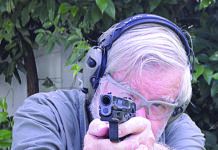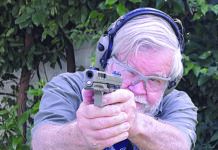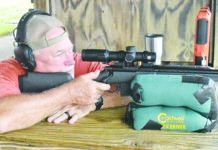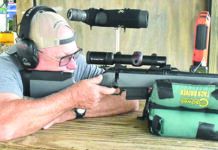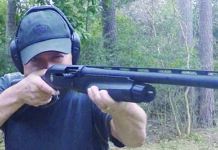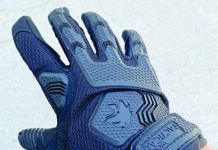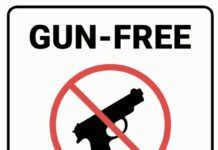[Updated May 1, 2019]
There are just too many designs of firing pins for them all to be listed and illustrated here, so we’ll just look at the types you’ll likely to run into.
What virtually everybody knows is that a firing pin is the object that hits a primer to set it off. However, firing pins that have the sear notch built into them, like the P-08 Parabellum and many of the smaller automatics, are properly called strikers. (This term is really unimportant when discussing problems, but might make a difference in the impression you give one who knows the difference).
Strikers: These usually have a spring inside the body, therefore weakening the head to some extent. Since a striker is a straight-line device, it loses less energy to centripetal force. It may have more of a loss to friction than do the swung pins. Of course, strikers never are acted upon by a hammer. Strikers usually share a weakness found in many shotgun firing pins, so I make it a practice to dry-fire a shotgun or any other striker-equipped firearm only when absolutely necessary. Using an adequate dry-fire shell makes them less prone to breakage.
Some rifles, such as the Arisaka, Mauser, Mosin-Nagant and others on the Mauser design, also use strikers. The 700 Remington has what looks like a striker, but it is a quasi-striker system because the firing pin is released by a camming action and not the sear.
Transfer Bar: In the 1970s, gun accidents and disproportionate jury awards prompted many manufacturers to modify their designs to include a bar or other mechanism to transfer the hammer’s momentum to the firing pin only when the trigger was pulled. This was supposed to eliminate misfires when the firearm was dropped on the hammer or in such a way that the blow caused the gun to fire.
In revolvers, this mainly appeared as a bar that lifted up when the trigger was pulled and was safe from the hammer due to a recess in the front of the hammer.
Hammer Block: Other manufacturers saw transfer bars as backwards and employed a similar mechanism to block the hammer from the firing pin. In the case of firing pins attached to the hammers, this blocking bar kept both the hammer and the firing pin from the primer.
Cam-up System: Firing pins that are cammed up out of the path of a hammer until the trigger is pulled or another safety system is disengaged use this method. A prime example of the cammed firing-pin safety is the Mauser HSC. On this gun, the firing pin is cammed up out of reach of the hammer and is fairly safe.
Firing-Pin Locking Pins: Some otherwise good firearms whose manufacturers felt compelled to place blocking devices directly in contact with the firing pins, notably the Colt Series 80, use this system. In that 1911, several levers must be moved by the trigger before they raise a spring-loaded blocking pin out of the locking notch in the firing pin. Owners will undoubtedly approach you to remove their firing-pin blocking safety, to basically make this one into an earlier version by leaving out the parts that block the firing pin. Although I consider the Series 70 safe without it, civil juries aren’t known for being logical when removing any safety. Do yourself the favor of not putting you and your family in a potential position of financial ruin. I don’t even do it with a signed waiver.
Nose: That part of the firing pin that comes in contact with the primer.
Shoulder: The stepped, increased diameter from the nose of the pin to the body, or main bulk of that pin.
Spring Recess: The hollow portion of the striker’s body that holds the firing pin spring. In the striker’s case, there is no hammer, so the firing pin’s energy comes entirely from the spring in the recess at the rear of the striker. The spring is usually referred to as a firing-pin spring and not a striker spring.
Drill Rod: As the name implies, drill rod is a class of steel used to make drills and is one of the most useful raw materials found in any machine or gunshop. The rod is supplied annealed (unhardened) so it can be machined more easily. Whether it is hardened after the part is shaped depends on how the part will be used. In the case of firing pins, the nose shouldn’t be hardened because this is just inviting the tip end of the pin to divorce the rest of the pin. The rear end, the part that the hammer will be striking, should be hardened to a tough stage so it won’t get beaten out of shape and be less effective. I buy drill rod in the O-1 or W-1 grades because they are oil-hardening and water-hardening, respectively, as well as controllable. I find A-1, or air-hardening, less controllable because it isn’t as easy to anneal or coax into a predictable degree of hardness.
Brownells and McMaster-Carr are two very good suppliers of drill rod. I usually get mine through Brownells when I order other supplies. Brownells handles both O-1 and W-1 rod stock, an indication that at least someone shares my lack of enthusiasm for air-hardening steels. Brownells also handles a steel called “Fatigue Proof,” mainly for firing-pin construction. I have not had it fail yet.
ScotchBrite: This is a common 3M product used for scouring pads, only I use the ScotchBrite wheels on a grinder to smooth and polish all stress-risers from firing pins I’ve sweated over. Stress-risers are non-radiused corners or any groove or scratch that could tend to be the start of a fracture. Of course, the ScotchBrite cannot remove an inside corner but it can blend out small scratches and pits.
Revolver firing pins can be divided into two classes, passive and active.
Passive Firing Pins: There are so many pins that can be used in a given situation and fit inside the spaces given to them, but narrowing down the field is usually easy if you keep in mind what the pin has to accomplish to fire the weapon. If the hammer is exposed, as on most revolvers, the firing pin will be the passive kind that remains in the frame and is struck by the hammer or a hammer-transfer mechanism. There will be an obvious socket for this type of firing-pin layout.
Designing a replacement firing pin for a revolver entails following the same steps and clues you would for the passive, shotgun firing pin.
Active Firing Pins: If the hammer has a hole in the front or a cross-pinning hole in its side, it had an active firing pin, one that swings with the hammer and strikes the primer through a hole in the frame.
Active firing pins usually fall into two main types: the integral pin, which is built into or solidly fixed to the front of the hammer; and the swiveling pin that has a pivot pin through it, as typified on S&W revolvers.
Fixed Firing Pins: The idea of a fixed firing pin on a hammer can be considered from either an economic standpoint or for simplicity. Having never had a swiveling firing pin fail, I feel there is no excuse for using the fixed one except economy. If a hammer needs another fixed firing pin, take extra care to see why the thing broke in the first place because it shouldn’t happen under normal circumstances.
Swiveling Firing Pins: Curiously, some S&W models have sprung, pivoting firing pins, while some are unsprung. It seems the larger frame models have the nice spring, but I fail to see why they need the feature more than the slightly smaller models. The centrifugal force that makes the firing pin’s nose tilt outward acts similarly on the smaller frame-types because their tighter swing radius compensates for the usually higher velocity of the longer swung pins. Either way, the nose of the pin has to be cammed so it doesn’t hit on the firing pin clearance hole, or it needs a spring strong enough to cancel the effect of the centrifugal force. Enlarging or slotting the firing pin hole to clear the pin is unsafe because it invites a ruptured primer.
I prefer the springing, since it doesn’t involve an impact or scuffing as does the camming method. Because the pin strikes the primer while describing an arc and moves inward while denting the primer, it must either swivel or drag across the primer while it is exerting quite a force. The latter tends to make primer rupture and tearing more likely at pressures lower than could happen with a swiveling firing-pin design.




